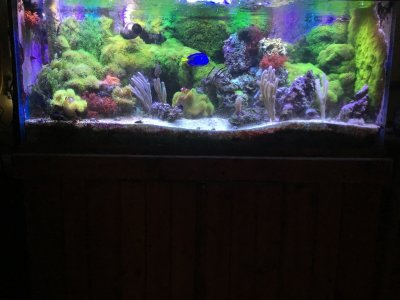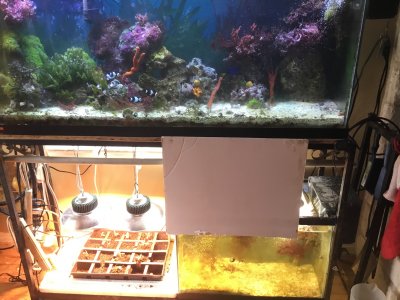In September of 1971, I started my marine aquarium journey after I entered the Texas Maritime Academy on Pelican Island in Galveston. Chemical Oceanography was my first technical elective which addressed Dynamic Equilibrium between carbon dioxide in the athmosphere and sequestered carbon in limestone sediments that use carbonate & bicarbonate alkalinity that buffer pH but more importantly when combined with photosynthesis brings the inorganic world into the organic world by moving glucose as a carbon source up the food chain.
On Christmas 1971, I set up a Galveston Bay theme tank with water collected from the Galveston jetties on an incoming tide. The 55G aquarium had a standard undergravel filter with air lift bubbles polling tank water into substrate. For substrate I used crushed oyster shells from chicken feed store. For livestock I collected grass shrimp & green mollies from grass flats. From the jetties, I collected anemones and from inland reefs I collected live oyster cluster encrusting with barnacles and stuff. Ten years later after moving this aquarium three times, I was showing the tank off with the crystal clear water with the dark maroon covering over the sandbed, when the guest blurted out, “why are you covering your sandbed with Cynobacteria”. We have come a long way since that time.
As I learn more after 50 years, I realize how much I don’t know. Cross talking between coral and bacteria, crosstalk between bacteria in the biofilm of macro and bacteria in algae interior to excercise gene expression in response to environmental conditions. Imagine that, bacteria having an awareness to alter gene response in other bacteria for the common good. Its in the genetic dna code.
My understanding of reef chemistry has evolved to include a third major player in reef chemistry: Bacteria, Algae, and Cryptic Sponges. On my 75G display, I will illustrate the players as being interconnected and interdependent of each other. For 20 years this display was set up as a Jaubert Plenum with a 6” dsb the 30G refugium was set up as an EcoSystem mud/macro refugium. Five years ago, I remove 60% of substrate and modified Jaubert plenum to reverse flow ug filter. I also removed lights & macro and seeded refugium with cryptic sponges & mature live rock.. So, the refugium is a mud/MULM incubator for the microbial loop and a cryptic refugium which processes all DOC into DIC to be processed back into glucose by photosynthesis. It is a positive feedback loop using a diversity of cryptic fauna.
https://link.springer.com/chapter/10.1007/978-3-030-20389-4_9
While sponges are the oldest still living multicellular animals on this planet and omnipresent within aquatic ecosystems, they have not been studied nearly as much compared to the recognized ecosystem drivers in coral reefs: corals, algae, and fish. We therefore want to take this opportunity to illustrate the diversity, functionality, and sheer survivability of these ancient animals. Beyond its multitude of external shapes and colors, sponges hold a unique internal aquiferous system. This system of afferent and efferent canals is intricately linked to supply its key function as a filter feeder. By filtering both particulate and dissolved material, sponges fill a niche in nutrient cycling. Moreover, the survivability of sponges is demonstrated in the variety of habitats it resides in; from freshwater canals to polar deep seas. In formerly uninhabitable environments, sponges can potentially create biodiversity hotspots by providing habitat complexity and shelter from predators. This review will give insight into the early life history, morphology, diet, and reproduction of sponges. Furthermore, it is imperative to consider their function as habitat facilitator, nutrient cycler, and, last but not the least, their potential for future pharmaceuticals. The emphasis in the proceedings has been specifically put on the role of sponges as nutrient cycler as they play a role in the three essential elements: carbon, nitrogen, and phosphorous. With all this in mind, it should be clear that even though sponges are relatively overlooked marine invertebrates, they should be studied similarly t
On Christmas 1971, I set up a Galveston Bay theme tank with water collected from the Galveston jetties on an incoming tide. The 55G aquarium had a standard undergravel filter with air lift bubbles polling tank water into substrate. For substrate I used crushed oyster shells from chicken feed store. For livestock I collected grass shrimp & green mollies from grass flats. From the jetties, I collected anemones and from inland reefs I collected live oyster cluster encrusting with barnacles and stuff. Ten years later after moving this aquarium three times, I was showing the tank off with the crystal clear water with the dark maroon covering over the sandbed, when the guest blurted out, “why are you covering your sandbed with Cynobacteria”. We have come a long way since that time.
As I learn more after 50 years, I realize how much I don’t know. Cross talking between coral and bacteria, crosstalk between bacteria in the biofilm of macro and bacteria in algae interior to excercise gene expression in response to environmental conditions. Imagine that, bacteria having an awareness to alter gene response in other bacteria for the common good. Its in the genetic dna code.
My understanding of reef chemistry has evolved to include a third major player in reef chemistry: Bacteria, Algae, and Cryptic Sponges. On my 75G display, I will illustrate the players as being interconnected and interdependent of each other. For 20 years this display was set up as a Jaubert Plenum with a 6” dsb the 30G refugium was set up as an EcoSystem mud/macro refugium. Five years ago, I remove 60% of substrate and modified Jaubert plenum to reverse flow ug filter. I also removed lights & macro and seeded refugium with cryptic sponges & mature live rock.. So, the refugium is a mud/MULM incubator for the microbial loop and a cryptic refugium which processes all DOC into DIC to be processed back into glucose by photosynthesis. It is a positive feedback loop using a diversity of cryptic fauna.
https://link.springer.com/chapter/10.1007/978-3-030-20389-4_9
While sponges are the oldest still living multicellular animals on this planet and omnipresent within aquatic ecosystems, they have not been studied nearly as much compared to the recognized ecosystem drivers in coral reefs: corals, algae, and fish. We therefore want to take this opportunity to illustrate the diversity, functionality, and sheer survivability of these ancient animals. Beyond its multitude of external shapes and colors, sponges hold a unique internal aquiferous system. This system of afferent and efferent canals is intricately linked to supply its key function as a filter feeder. By filtering both particulate and dissolved material, sponges fill a niche in nutrient cycling. Moreover, the survivability of sponges is demonstrated in the variety of habitats it resides in; from freshwater canals to polar deep seas. In formerly uninhabitable environments, sponges can potentially create biodiversity hotspots by providing habitat complexity and shelter from predators. This review will give insight into the early life history, morphology, diet, and reproduction of sponges. Furthermore, it is imperative to consider their function as habitat facilitator, nutrient cycler, and, last but not the least, their potential for future pharmaceuticals. The emphasis in the proceedings has been specifically put on the role of sponges as nutrient cycler as they play a role in the three essential elements: carbon, nitrogen, and phosphorous. With all this in mind, it should be clear that even though sponges are relatively overlooked marine invertebrates, they should be studied similarly t


